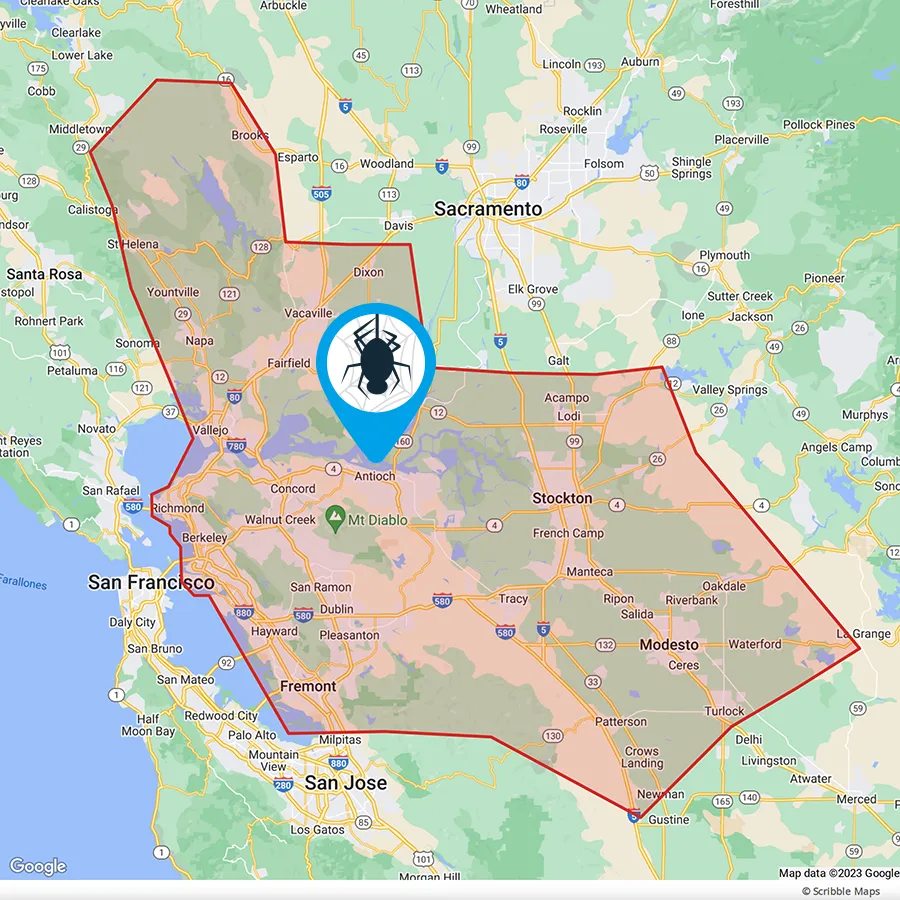Common Spiders We Eliminate for You
While many spiders are harmless to humans, they can create a mess with their webs in and around your home. Some spider species, like the Black Widow, can be venomous and pose health risks to you and your family.
Because spiders have many ways to enter your home, the most effective solution is a Pest Control Strategy that solve the current infestation, which prevents your home from being targeted in the future. Continue to read below to learn more about the spider control treatments available to you.
When you are ready to start living spider-free, our friendly Pest Control Specialists are here to guide you through our proven Pest Control Strategy. Taking action at the first sign of spider activity is the best way to prevent a larger infestation from spreading in your home.
Give our customer satisfaction specialists a call today to take advantage of 20% off your first month of our All N One Pest Control & Maintenance Service.
There are over 40,000 different spider species around the world. Luckily there are a far less in Northern California. Our Diamond Certified Spider Control Experts have been trained to locate, identify, and eliminate the eight-legged pests invading your home. The most common spiders we eliminate for customers just like you are:
Black Widow Spiders
The black widow spiders are identified by their color and the hourglass-shaped mark on their abdomen. These spiders may be small but their venomous bite can pack a punch. According to WebMD, the effect of the venom can vary from person to person causing severe pain, burning, swelling and redness around the bite. Nausea, vomiting, and difficulty breathing are also potential symptoms. WebMD also recommends children and older adults immediately seek medical attention as their bites can be fatal to them. You can learn more about black widow bites on WebMD.com.
Hobo Spiders
These are aggressive house spiders which are 11 to 15 mm long and are brown in color. Females have larger abdomens as compared to male. Males have swollen appendages which are used for reproduction. They feed on insects and other spiders. They inhabit dark humid areas that are not commonly used.
Crab Spiders
Named after their crablike appearance and movements. They have two large and strong front legs that are used to capture their prey. Their bite is venomous, but it is not medically threatening to the human body. Crab spider eggs are produced a week after the crab spiders mate and hatching time depends on environmental conditions.
Garden Spiders
They are neither aggressive nor are they medically important. They are found outdoors and in gardens where they weave delicate orb-shaped webs. They produce strong webs which they use to capture their prey.
Daddy Longlegs
One of the most common spiders found in the home, the daddy longlegs is a member of the cellar spider family and also referred to as a harvestman spider. They do not pose a poisonous threat to humans.
Signs of a Spider Infestation
There are both obvious and less obvious signs you are experiencing a spider infestation in your home. Common signs of an active infestation or the potential of a spider problem include:
- Seeing an increase of spiders in or around your home
- An increase in spiderwebs around the corners of your walls, near windows or doorways, or behind bookshelves and other furniture
- Spotting spider egg sacks. The sacks are usually white in color, wrapped in the silk webbing, and are generally attached to a solid surface like behind a bookshelf or in cabinets.
Spider Control Treatments
While spiders are an important part of our ecosystem by providing organic bug control, they can still cause pest problems within your home. Additionally, some species can also cause health risks like the black widow. At All N One Pest Eliminators, our spider control treatment consists of both chemical treatments and natural control options.
Chemical Treatments
Aerosol concentrate sprays and insecticide “dust” are both common and effective treatments for larger infestations. The odorless dust is mixed with water and then applied in and around the infestation area. The dust treatment provides a waterproof solution which is sprayed into cracks and voids spiders and other pests can use to gain entry to your home. The treatment is highly effective, fast acting and can provide protection for a significant period.
Natural Control and Prevention
While chemical treatments are an effective way to control and eliminate large spider infestations, we believe ecofriendly organic and natural control and prevention options should be used when available. Modifying the environment where the spiders and other pest live can be an effective preventative option including:
Reducing the amount of artificial light outside
Many bugs are attracted to artificial light sources. The bugs that are drawn to the light provide an excellent source of food for spiders. Using motion detection light that only operate when needed is a great option to reduce artificial outdoor light.
Sealing Cracks and Gaps
Spiders and other pests can enter your home through the tiniest cracks and gaps around doorways, windows, or imperfections around the foundation. New seals, screens, and fillers can be used to seal these entry points.
Keep roof overhangs and base of your house clean
Debris, cobwebs, weeds and dirt around the base of you home and roof overhangs provide insects a perfect habitat to live. A shop-vac can be an effective too for reaching hard to reach areas when cleaning.
Move wood piles away from home
Piles of wood, like supplies of firewood, are notorious homes for spiders like black widows. While treatments around the wood can help minimize spider activity, it is a good practice to keep the wood stored away from your home. It is also a good practice to use gloves when gathering wood and inspecting it for spiders before bringing into the house.
Black Widow Spider Control Protects Your Family
Are Black Widow Spiders invading your home? Known for their painful and venomous bite, these spiders create a potentially harmful situation for you and your family. Taking quick action to eliminate black widows from inside and around your home is the best way to protect your loved ones.
The most effective way of eliminating black widows from your home is with a pest control strategy that solves the current spider infestation and prevents your home from being targeted in the future. Continue to read below to learn more about the pest control treatments available to you, as well as additional information about the black widow spider.
When you are ready to start living spider-free, our friendly Pest Control Specialists are here to guide you through our proven Pest Control Strategy. Taking action at the first sign of a black widow is the best way to prevent a larger infestation from spreading in your home.
Give our customer satisfaction specialists a call today to take advantage of 20% off your first month of our All N One Pest Control & Maintenance Service.
Signs of A Black Widow Infestation
Black Widow Spiders are commonly found in dark places like crawl spaces, piles of wood, under bushes, garages, and in storage closets within your home. With their infamous shiny black bodies and red hour glass mark on the females, they are one of the easiest spiders to identify.
The black widow web tends to be very fine and shimmers in the light. An active web is kept very clean by the spider. They are not always immediately visible on or around the web as they are known to hide from their prey.
Signs of a Black Widow Bite
Although not generally lethal, the black widows bite is venomous, painful, and can cause a more serious allergic reaction requiring medical attention. Commonly reported signs and symptoms of black widow bite include:
- Nausea
- Muscle Pains
- Headaches
- Difficulty in Breathing
- Hypertension
If you experience any of these signs after getting bit, you should seek the advice of a medical professional.
Black Widow Facts
The female black widow is what most people picture when talking about this spider. Only the female carries the red hour glass marking on its abdomen. It will also grow larger than the male, capable of growing over 1 ½ inches long. As the alpha of the species, the “widow” name come from the female feeding on their male counterparts.
While the female mates only once during its lifetime, just one can create a large infestation. They can lay between 30 to 850 eggs which are incubated for three weeks. The offspring will reach maturity in just three months.
Black Widow Spider Control Treatments
Spiders are an important part of our ecosystem, they are vital in contributing to their natural organic bug control. However, the potential harmful effects of a black widow outweigh their usefulness in certain situations. At All N One Pest Eliminators, our black widow spider control treatment consists of both chemical treatments and natural control options.
Chemical Treatments
Aerosol concentrate sprays and insecticide “dust” are both common and effective black widow treatments for larger infestations. The odorless dust is mixed with water and then applied in and around the infestation area. The dust treatment provides a waterproof solution which is sprayed into cracks and voids spiders and other pests can use to gain entry to your home. The treatment is highly effective, fast acting, and can provide protection for a significant period of time.
Natural Control and Prevention
While chemical treatments are an effective way to control black widows, we believe eco-friendly organic and natural control and prevention options should be used when available. Modifying the environment where the spiders and other pest live can be an effective preventative option, including:
Reducing the amount of artificial light outside
Many bugs are attracted to artificial light sources. The bugs that are drawn to the light provide an excellent source of food for spiders. Using motion detection light that only operate when needed is a great option to reduce artificial outdoor light.
Sealing Cracks and Gaps
Spiders and other pests can enter your home through the tiniest cracks and gaps around doorways, windows, or imperfections around the foundation. New seals, screens, and fillers can be used to seal these entry points.
Keep roof overhangs and base of your house clean
Debris, cobwebs, weeds and dirt around the base of you home and roof overhangs provide insects a perfect habitat to live. A shop-vac can be an effective too for reaching hard to reach areas when cleaning.
Move wood piles away from home
Piles of wood, like supplies of firewood, are notorious homes for spiders like black widows. While treatments around the wood can help minimize spider activity, it is a good practice to keep the wood stored away from your home. It is also a good practice to use gloves when gathering wood and inspecting it for spiders before bringing into the house.

Areas We Service in Northern California
All N One Pest Eliminators proudly serves customers in Northern California. Our experienced technicians are capable of providing safe and effective pest control services to any location in our service area. Our service area includes the following:





